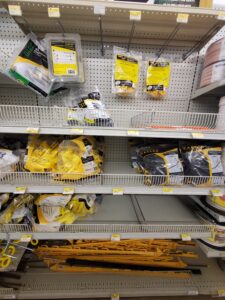No products in the cart.

When embarking on a DIY electric fence installation, it is crucial to have a good understanding of the key components and principles involved. One of the essential elements of an electric fence is the energizer, which provides the electrical pulse necessary to deter animals. The energizer is connected to conductors, which can be made of materials such as high-tensile wire or polywire, that carry the electrical charge along the fence line. Insulators play a vital role in preventing electrical leakage and ensuring that the current flows through the conductors and not into the ground. Ground systems, including ground rods or plates, provide a path for the electrical charge to dissipate harmlessly into the earth.
Choosing the Right Electric Fence Design for Your Needs:
There are various electric fence designs to consider when planning your installation. Single-wire systems are suitable for simple applications, while multi-wire systems provide additional containment options for different types of livestock. Netting systems are commonly used for temporary or portable fencing needs. When selecting the right design, consider factors such as the type of livestock you want to contain, the size and layout of your property, and your budget. For example, if you have horses, a design that incorporates multiple wires at different heights may be more suitable compared to a single-wire design.
Assessing Your Property for Electric Fence Installation:
Before starting the installation process, it is important to assess your property carefully. Consider the terrain of your land, as well as any vegetation that may interfere with the fence line. Identify the most suitable location for your fence, taking into account factors such as proximity to power sources and the presence of underground utilities. By conducting a thorough assessment, you can ensure a safe and effective installation that minimizes potential risks or complications.
Selecting the Proper Electric Fence Energizer:
Choosing the right energizer is a crucial decision when installing an electric fence. There are different types available, including battery-powered, solar-powered, and plug-in options. When selecting an energizer, consider factors such as the power output required to deter the animals you want to contain, the length of the fence, and the type of animals. For example, if you have a large property with no access to electricity, a solar-powered energizer might be the most practical and environmentally friendly choice.
Installing Fence Posts and Conductors:
Proper installation of fence posts and conductors is essential for the stability and functionality of your electric fence. Follow step-by-step instructions for post installation, ensuring that they are spaced at regular intervals and securely anchored in the ground. The choice of conductor material depends on factors such as the type of livestock and the level of containment required. For example, high-tensile wire is known for its strength and durability, making it suitable for large animals like cattle. Polywire, on the other hand, is lightweight and easy to handle, making it a convenient option for temporary fencing. For tips on post installation, check out our blog that walks you through the things you need to know
Installing Electric Fence Insulators:
Electric fence insulators play a crucial role in preventing electrical leakage and ensuring proper current flow along the fence line. Different types of insulators are available, including porcelain, plastic, or rubber. The choice of insulator material depends on factors such as durability, compatibility with the conductor material, and the specific environmental conditions. For example, porcelain insulators are known for their strength and longevity, while plastic insulators are lightweight and resistant to UV rays. Choose insulators that are suitable for your specific needs and provide effective insulation for your fence.
Grounding Your Electric Fence System:
Proper grounding is essential for the effective operation and safety of your electric fence. A well-installed ground system provides a path for the electrical charge to dissipate harmlessly into the earth. Ground rods or plates are commonly used to create a grounding system. The number and length of ground rods depend on factors such as soil conditions and the energizer’s power output. Adequate grounding ensures optimal performance of your electric fence and minimizes the risk of electrical hazards.
Connecting and Testing Your Electric Fence:
Once all the components of your electric fence are installed, it is important to properly connect and test the system. Ensure that all connections are secure and that conductors are properly attached to the energizer and insulators. Test the fence to ensure it is delivering an effective deterrent to animals. A voltage tester can be used to measure the voltage along the fence line and ensure that it is within the desired range. Regular testing and maintenance of your electric fence will help ensure its continued functionality and effectiveness.
DIY electric fence installation requires a solid understanding of the key components and principles involved. By choosing the right design, conducting a thorough property assessment, selecting the proper energizer, and following proper installation techniques, you can create an effective electric fence system. Proper installation of fence posts, conductors, insulators, and grounding systems, along with regular testing and maintenance, will ensure the functionality, durability, and safety of your electric fence. With the knowledge gained from this blog, you can confidently embark on your DIY electric fence installation project and effectively protect your property and contain your livestock.
Curious minds, you’re in the right place! Contact Cat’s Claw Fasteners and connect with our Head Cat Collector, Ralph, via email at ra***@***************rs.com. Stay informed with our blog and follow us on Facebook, Instagram, Pinterest, and Youtube for more updates!
About the writer: Jake
Jake Walker is Cat’s Claw Fasteners go-to guy for anything related to fencing, gates, installation, and materials! Thanks to his background as a professional fencing installer as well as content writer, combined with a bit of his British twang and ideas from across the pond, he keeps the audience captive. Don’t worry if you don’t understand his British slang or sense of humour; we don’t always understand him, and he doesn’t always fully understand us.
Get in touch of Jake via email at ra***@***************rs.com , be sure to use ATTN:Jake if you have any questions about all thing social, writing, fencing, or just want to make fun of his British accent.
Read Next: Different Types of Fences and When To Use Them

© 2024 Cat's Claw Fasteners, LLC | All Rights Reserved - Built by Redemptive Software